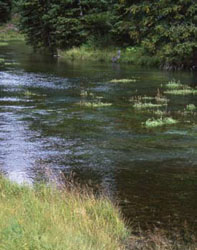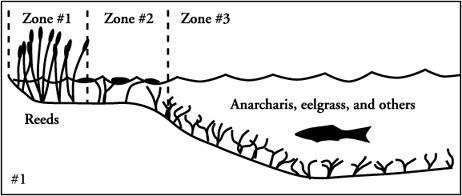Aquatic Plants
The presence of aquatic plants is one of the best indicators of whether a lake or a stream will be a good producer of fish. Most aquatic life which fish feed upon requires these plants for food. Plants also provide a fishery with protective cover and life-giving oxygen.
Aquatic plants are classified into submerged, floating, and emergent varieties.
Submerged plants are rooted on the water’s bottom but do not extend all the way to its surface. Eelgrass is an example

of a submerged plant. Floating plants are not rooted and are free to move about the water’s surface. Duckweed is an example of a floating plant. Emergent plants are rooted on the water’s bottom and extend to its surface. The waterlily is an example of an emergent plant.
The most important plant class is the submerged variety because it provides an abundance of aquatic food on the lake’s or stream’s bottom. It is also easier to fish than the other two because it produces less plant clutter and snags.
Plants require sunlight for growth and photosynthesis to occur. Plants are restricted to waters receiving sunlight. In most waters, a depth of ten to thirty feet is the limit that sunlight can penetrate. This means that plants are most abundant in the shallows and decrease in quantity as the water deepens. Shallow shorelines protected from floods and wave actions favor the most abundant growths.
In general there are three zones of aquatic plants. (See Diagram 1) The first zone consists mainly of rooted plants with their tops extended to the surface air. These consist of emergent plants. They occur in depths from the edge of shorelines to about the six foot depth. Cattails, reeds, and others are common plants found in this first zone.
The second zone is made up of rooted plants which shelter floating portions on the surface. This zone is deeper than the first zone and spreads to about the ten foot depth. Waterlilies and pond weeds are examples.

The third zone lies in the deeper areas beyond the first two zones. It includes submerged plants such as eelgrass, Anarchasis and others. This zone advances close to a ten foot depth. In very deep, clear waters where sunlight can penetrate deeper, this zone may extend to about the thirty foot depth. Large dense growths of submerged plants are frequented by feeding fish. Submerged plants in the deeper areas are difficult to see and to determine their presence.
These three zones somewhat overlap. In areas of heavy currents, flood and wave action can dismantle plant growth and in some of these areas plants may be absent.
The most desirable plants to locate are the submerged growths of zone three. These support adequate depth for protective cover and an ample food supply.
Specific plants are favored by different aquatic life forms. Callabaetis mayflies, dragonflies and damselflies are found in certain plants such as the submerged varieties. These insects are stalkers and lie in wait to prey upon their victims.
Fish forage the aquatic plants looking for food. It is these plants that generate most of the fish’s food supply.

© 2025 The Gale Group, Inc. All rights reserved.
© 2025 Perigee Learning LLC. All rights reserved.
LoveTheOutdoors.com is owned and operated by Advameg, Inc. © 2025 Advameg, Inc.
Camping Adventures • Dutch Oven Cooking • Sports Knots
Fly Tying • Freshwater Fishing • Fly Fishing

